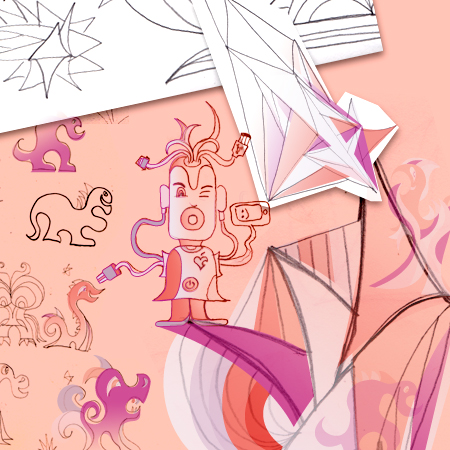You know they’re in there. They want to come out. All those clever ideas, witty lines and Steve Job-esque innovations that seem to come to mind at the least opportune moments.
Like during the morning freeway crawl, a visit to the water closet or in the midst of some golden slumber at 3:00 AM. Like playful toddlers, these promising ideas tend to act up when you are crazy busy yet seem to run off and hide the moment you try to reign them in to do a little work.
Instead of having a demoralizing face off with a blank sheet of paper or digital equivalent, I found there are ways of getting these fickle ideas to come out of hiding and eventually get to work. Instead of strong-arming them to obey your command, you need to play around, just like them, and slowly draw them out (sometimes, literally).
The solution is simply this: writing, sketching or brainstorming on paper, done at the start of your day, for a minimum of two pages. If you are an artist, designer or illustrator looking for new visual ideas, start with a sketchbook and just doodle and doodle and doodle away. Don’t worry if it looks good. Allow yourself to draw poorly at first. Sketch as much as you like but set a hard limit of 2 pages.
If you are a writer or someone who has thoughts you want to get out of your dome, buy a blank note pad and just write. Even if you don’t know what to say, just keep the pen to the pad or the fingers to the keys and keep writing. Like sales, creativity can be a numbers game where you need to crank out a few bad pages to eventually get to something fresh, exciting and new.
This process was first introduced to me through a painting teacher who noticed I had a habit of working my paintings for too long. He encouraged me to “get in and get out” and produce a larger body of work rather than trying all semester to make a one or two masterpieces. The results of this prolific, sprint-like process produced dramatically better work (and more of it).
Later, it was reintroduced to me in the timeless classic The Artist Way. Author Julia Cameron uses a process she calls morning pages to help writers produce new ideas, crack the dreaded writers blocks or find their unique voice. She suggests to get three pages done, first thing in the morning. I’ve found this works for any discipline, not just writers, but I prefer two pages if it’s sketching or anything not free form writing. It’s just a more reachable goal that helps me feel accomplished.
Being the curious artist I am, I tend to mix it up to include sketches and/or mind-mapping brainstorms in addition to writing. I tend to pick one and do it for long stretches of a few weeks as this has shown to produce the best results without burnout. So mix and match the focus of your pages all you want however, a huge key is to consistently show up, around the same time each if possible.
Which method to try?
I use the three different methods (sketching, writing, brainstorming) to induce different results or growth.
I use the writing to help me process thoughts, empty my mind or generate writing ideas. I then take these writings and massage them into blog articles and newsletters. However, writing has also helped me tremendously in interpersonal conversations with clients, colleagues, friends and family.
Sketches help break me out of creative plateaus where I find myself gravitating to the same visual or familiar design solutions. Sketching for long stretches helps me explore new techniques and form new styles. Before long, I have a mountain of sketches that helps fuel both my client and personal work.
Brainstorming simply helps me generate a slew of topics and concepts. I tend to do this when the other two options stagnate or when I’m looking take an idea further. I sometimes double down and explore my brainstorming results deeper in writing or sketches. Again, the mixture of the three tools (sketching, writing or brainstorming) is where some real creative fireworks can happen. It’s not a science, but at times, it’s feels like one.
Yes, sometimes great ideas are like toddlers, you need to reach them through play and routine. If I routinely show up in the morning and allow myself to play in the process above. My ideas tend to show at that time as well.
While this may sound like a preference to quantity over quality, it’s really an acknowledgement that sometimes it takes quantity to get to quality. Proof—that creativity is 99% perspiration and 1% inspiration.
- Actions For You:
- 1. Pick one method (sketching, writing or brainstorming) and commit to that one method for a few weeks to start before mixing.
- 2. Buy the tools you feel you need. Two to three blank sheets of paper and a sharp pencil is all you need. A new journal or sketchbook, dedicated to this process only is best (try to stay analog if possible).
- 3. Designate a place to do this work (preferably away from the usual desk). I use my kitchen table and leave my tools out the night before (my time is 5:30 am).
- 4. Schedule it and stick to it.


Leave a Reply